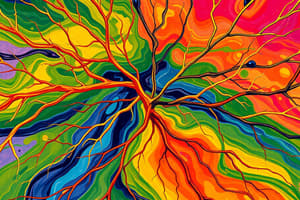Podcast
Questions and Answers
What is the primary function of sensory nerves in the peripheral nervous system?
What is the primary function of sensory nerves in the peripheral nervous system?
- Regulate involuntary bodily functions
- Control voluntary muscle movements
- Convey information from receptors to the CNS (correct)
- Transmit messages from the CNS to effector organs
Which of the following is NOT a component of the central nervous system?
Which of the following is NOT a component of the central nervous system?
- Peripheral nerves (correct)
- Brain
- Motor neurons
- Spinal cord
What do motor nerves in the peripheral nervous system primarily do?
What do motor nerves in the peripheral nervous system primarily do?
- Control the sense of touch
- Convey information from receptors to the CNS
- Initiate responses and movements in effector organs (correct)
- Transmit messages to sensory organs
Which type of neurons are found in both the peripheral and central nervous systems?
Which type of neurons are found in both the peripheral and central nervous systems?
Where are touch receptors in the human body mainly located?
Where are touch receptors in the human body mainly located?
In what direction do motor nerves transmit messages in the peripheral nervous system?
In what direction do motor nerves transmit messages in the peripheral nervous system?
What distinguishes unipolar neurons from bipolar neurons?
What distinguishes unipolar neurons from bipolar neurons?
How do some nerve fibers enable communication across opposing sides of the body?
How do some nerve fibers enable communication across opposing sides of the body?
What is a common symptom of Carpal Tunnel Syndrome?
What is a common symptom of Carpal Tunnel Syndrome?
What triggers Guillain-Barré Syndrome?
What triggers Guillain-Barré Syndrome?
How does evolution contribute to the robustness of the PNS?
How does evolution contribute to the robustness of the PNS?
How does understanding the peripheral nervous system benefit individuals?
How does understanding the peripheral nervous system benefit individuals?
Study Notes
Exploring the Peripheral Nervous System
The human body's intricate communication network is controlled by two primary components: the central nervous system (CNS) and its counterpart, the peripheral nervous system (PNS). Let's delve into this fascinating aspect of biology—our PNS—to better understand how it functions and interacts with our everyday lives.
Overview and Major Divisions
The PNS encompasses all neural pathways outside the CNS, which includes the brain and spinal cord. These connections transmit information between the CNS and sensory organs like our eyes, ears, nose, skin, and muscles throughout the rest of our bodies.
For simplicity, the PNS can be divided into distinct categories based on their function:
-
Sensory nerves, also known as afferent fibers, convey information from receptors located within various tissues and organs to the CNS. Examples include touch receptors in your skin and pressure sensors in muscles.
-
Motor nerves, also referred to as efferent fibers, transmit messages from the CNS to effector organs such as glands, smooth muscle tissue, and striated (skeletal) muscle cells, initiating responses and movements. For instance, motor signals travel from your brain through the PNS to enable hand movements when you type on a keyboard.
Organization and Structure
The PNS contains both unipolar and bipolar neurons, whereas the CNS solely possesses multipolar neurons. Unipolar neurons send a single axon outward before splitting it into multiple branches, allowing them to communicate with several different target cell types. Bipolar neurons have one short axon extending towards a single target cell type.
Like many systems in nature, evolution has endowed the PNS with redundancy to ensure continuous functionality despite potential damage. In fact, some nerve fibers may even cross over midline structures within the body, enabling communication across opposing sides of the body if required.
Disorders Affecting the PNS
Although the PNS is typically robust and resilient, malfunctions do occur due to injury or disease. Some common examples include:
-
Carpal tunnel syndrome: Compression of the median nerve results in pain, numbness, and weakness within the affected limb. This condition primarily affects individuals who perform repetitive tasks involving wrist movement or excessive typing.
-
Guillain-Barré Syndrome (GBS): An autoimmune response lead to inflammation and swelling along the PNS nerve fibers. Symptoms include rapid muscle weakness progressing upwards from the lower extremities, eventually affecting breathing muscles. GBS is often triggered following respiratory or digestive tract infections.
Understanding the peripheral nervous system illuminates the sophisticated underlying processes responsible for coordinating bodily activities that we engage in daily without conscious thought. As you continue learning about the marvelous complexity of life itself, consider exploring further aspects of neuroscience to broaden your understanding of the human mind!
Studying That Suits You
Use AI to generate personalized quizzes and flashcards to suit your learning preferences.
Description
Dive into the intricacies of the peripheral nervous system (PNS), the critical network connecting the central nervous system (CNS) to sensory organs and muscles. Learn about the major divisions, organization, structures, and disorders affecting the PNS.




